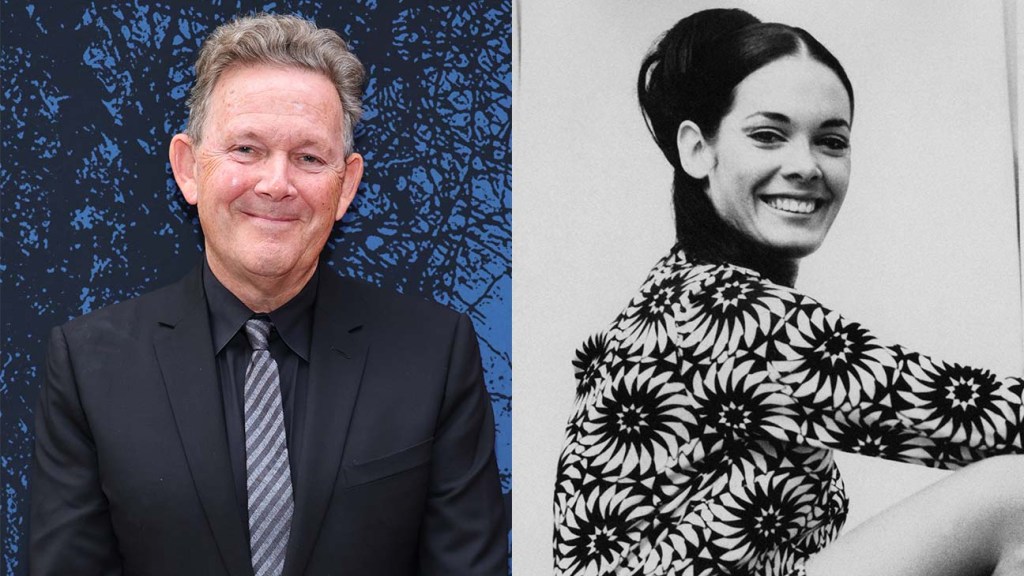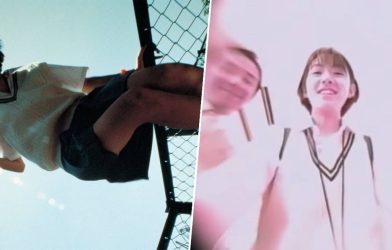
John Logan and Martine Beswick
Theo Wargo/Getty Images; John Pratt/Keystone Features/Hulton Archive/Getty Images
A playwright-turned-screenwriter, John Logan made a name for himself — and earned three Oscar nominations — working with some of the biggest names in the business, in genres ranging period dramas, sword-and-sandal epics and spy thrillers.
His credits include Martin Scorsese’s The Aviator, Tim Burton’s Sweeney Todd, Oliver Stone’s Any Given Sunday, Ridley Scott’s Gladiator, Ed Zwick and Tom Cruise’s The Last Samurai, and two James Bond movies directed by Sam Mendes, to name a few.
Logan was, in his own words, shaped by two early influences: William Shakespeare and monsters. The Great Bard led him to drama, theatre, and a career in writing. But even before that, there were monsters. He was raised on the fantastical world of Dark Shadows, the horror movies of Universal and Hammer, Famous Monsters of Filmland magazine, the Aurora monster modeling kits, and Marvel’s Tomb of Dracula comic books. His first produced screenplay was 1999’s Bats, about mutated rampaging bats. More recently he did a slasher movie with an LGBTAQ bend titled They/Them.
“Genre matters,” Logan writes in an email to The Hollywood Reporter. “Horror is meaningful. It deserves to be taken seriously. The best horror films let us to view ourselves through a darkly metaphoric lens. We learn to grapple with fear, with loss, with the unknown and unknowable, through genre films. We learn to be brave. To recognize and battle evil. To endure. And to survive.”
The writer was recently revisiting some of the classic British Hammer horror movies and came across an old favorite, Dr. Jekyll and Sister Hyde. He hadn’t seen it in years.
“It was a revelation to watch it now,” Logan writes. “To see complex gender politics and queer issues so boldly dramatized in a movie from 1971. And burning through the celluloid is the striking central performance of Martine Beswicke. This led me on a deep dive into All Things Martine.”
Logan was inspired to pen an appreciation to the actress, who rose to prominence thanks to appearing in two classic James Bond movies – From Russia With Love and Thunderball – as well as One Million Years B.C. with Raquel Welch. Starting in the late 1960s and into the 1970s, she made her mark in a string of low-budget movies made by British horror house Hammer Film.
The actress is still alive at the age of 82 so this is in no way a remembrance. This is a simply one fan writing about the impact an artist had on their life. We should all get something like this while we’re still alive to read or hear it.
Read his letter below.

THUNDERBALL, Martine Beswick, Sean Connery, 1965
Courtesy Everett Collection
When you work in the horror genre, you spend a ridiculous amount of time worrying about evil. You’re constantly writing it, planning it, explaining it, dramatizing it. You feverishly think up new mythologies. You curate your nightmares and try to capture them on screen. Is your villain or monster going to be scary or seductive or sinister? Are you going for a darkly sympathetic figure or a bloody ravening beast? How do you make something unique in this bountifully busy genre?
These questions were at the forefront of my work when I was writing and producing the Victorian gothic television show Penny Dreadful for Showtime. Hitting the tone of the series was always a challenge. After a while I had a go-to answer when actors would occasionally ask about how to calibrate a villainous performance that was at once dramatically heightened but honest, stylish but sincere, heartbreaking but horrific. I recommended they watch Martine Beswicke in the 1971 British horror film Dr. Jekyll and Sister Hyde to see chic Grand Guignol as its most passionate and most honest.
So, all hail the ferocious glory that is Martine Beswicke.
In the long parade of horror cinema’s virginal ingenues, wan heroines, willowy victims, and helpless damsels-in-distress, Martine Beswicke stands apart. She is the most modern Scream Queen of them all — because she never screams, she never cowers, she never shrinks back. She is a dark, rakish silhouette made to trouble your dreams, to destroy you with her panache and make you glad you came to such an outré and stylish end. It’s hard to resist the force of nature that is Martine Beswicke.
Until we met her sisters Jamie Lee Curtis on the mean streets of Haddonfield in Halloween and Sigourney Weaver in the dripping corridors of the Nostromo in Alien, Martine was our true badass horror queen. As an actress she created a unique persona that transcended movies both good and bad. The characters might be called “Sister Hyde” or “Nupondi” or “Queen Kari” but they are still somehow all Martine: imperious, playful, dangerous, and fearless. You always get the sense that Martine herself is in on the joke and is slyly letting you in on it too. She seems to revel in this meta-cinematic awareness the way Vincent Price sometimes did. To watch Martine act is to relax because she’s so supremely assured. She’s in control. She’s got this. Don’t worry your pretty head, dear, Martine will take care of it.
Although I wish I had her swaggering confidence, Martine Beswicke and I actually share only one thing: we both worked on two 007 movies. After her supple and athletic turns in From Russia With Love (1963) and Thunderball, (1965) she sauntered into the three Hammer Film movies that made her famous. She was unique at Hammer and in British cinema at the time because she is mixed race, Jamaican-Portuguese and British. She looked like no one else: impossibly statuesque; dangerous bone structure; long and loose dancer’s frame; proudly owned sexuality. She is the photo negative of the traditional English Beauty Rose. Back in the mid-late sixties, this marked her for exotic and villainous roles.
And these roles seemed to suit her, to allow the character of Martine the Mighty to emerge as a fresh new idea in horror cinema. She became her own mini genre.
In the prehistoric epic One Million Years B.C. (1966) she catfights like a demon and steals the movie from Raquel Welch and some terrific Ray Harryhausen stop-motion dinosaurs, no mean feat. Look how coiffed and poised the wonderful Raquel seems next to the feral and raw Martine. Feral and raw will win every time. As Queen Kari in the dotty adventure tale Prehistoric Women (1967) she out-Ayeshas Ayesha: Martine is the ultimate She Who Must Be Obeyed. I wish she had gotten to play the actual Ayesha in some cinematic version of H. Rider-Haggard’s She as she would have been definitive. In Prehistoric Women Martine gives a wonderfully lurid and sensuous performance in, it must be said, a less than stellar movie. But Martine’s entertaining and undulating Dance of Death and sheer animal magnetism are certainly worth a visit to Hammer’s lunatic “Enchanted Land of the White Rhino.”

Dr. Jekyll and Sister Hyde
Courtesy Everett Collection
And then there’s 1971’s Dr. Jekyll and Sister Hyde.
If you don’t know this movie, the crafty title says it all. In this version of the oft-filmed Robert Louis Stevenson story, Dr. Jekyll (played by Ralph Bates) transforms into a female-presenting version of himself (played by Martine.) To say more about the plot would deny you the pleasure of witnessing the jaw-droppingly bizarre twists and turns. It’s a film, to use Oscar Wilde’s phrase, “crowded with incident.”
To many horror fans, Vincent Price gave his greatest performance in Witchfinder General, the bleak and bloody 1968 Michael Reeves masterpiece. In this movie, Price let his droll affectations drain away and he created a character of inexorable evil. It’s a compelling performance. Dr. Jekyll and Sister Hyde is Martine Beswicke’s Witchfinder General, her transcendent performance, her most fully realized role.
And I just love this movie. I love it for its insanely ingenious Brian Clemens script, you can tell it was written by one of the febrile and whimsical minds behind The Avengers. I love it for its archly theatrical soundstage sets with their self-aware forced perspectives. I love it for its splashy freedom with the old Kensington gore, its unapologetic and over-the-top bloodiness. I love it for its postmodern mash up of Jekyll, Hyde, Burke and Hare, Jack the Ripper, with a bonus shout out to Sweeney Todd and musical number to boot. I love it for Ralph Bates’ insecure and awkward Dr. Jekyll. I love it for Martine’s complex and hot/cold Sister Hyde.
But I love it most of all for its intricate gender politics. It’s a thorny and nettlesome movie – as all good horror movies should be. It forces you to think. It’s slippery. Is it transphobic? Homophobic? Or is it a coded celebration of Victorian queer identity and desire? Is it a down-and-dirty erotic exploitation movie? Or is it sly female empowerment metaphor? Is it a revenge fantasy for the rejected in society, the outcasts, the others, the different? Or is it, alchemically, all of these at once? Without a doubt it is one of those rare horror movies which is deeply embedded with serious ideas. To watch this movie is to be provoked.
For me, though I can see many textual readings of the movie, it works most powerfully as a trans wish fulfilment story: Jekyll’s transgressive exploration of his/her/their true self. Sister Hyde is no more “evil” or murderous than the coldblooded Dr. Jekyll, she’s just a different gender expression of Jekyll’s hubris, narcissism, and hidden desire. When Doctor becomes Sister, and Sister becomes Doctor, both gradually become well and truly They, complete and authentic. Authentically monstrous to be sure, but strangely unified after their internal battles. To a modern audience, the trans and queer subtexts of the story aren’t especially subtle and they’re played to the hilt by Ralph Bates and Martine Beswicke. They knew what they were up to. They knew what this movie was actually about.
In serious horror film criticism, different readings of Dr. Jekyll and Sister Hyde abound. Some plain dislike it, or sniff at its sexual themes, or dismiss it as a late-Hammer Films mediocrity far removed from the glory days of the earlier Peter Cushing/Christopher Lee Dracula and Frankenstein movies. But to me Dr Jekyll and Sister Hyde is unique in the distinguished Hammer Films canon because it is the most modern of them all. It has survived the years and has emerged, resilient and meaningful, challenging and comforting, speaking to us now. It is not quaint Victoriana, this movie, it’s a direct assault on conventional and simplified gender assumptions. It takes no prisoners.
And Martine Beswicke gives the performance of her career. She is mesmerizing to watch; witness her louche freedom in Dr. Jekyll’s dressing gown, her savage joy in both the carnality and the violence, her dawning realization of her transforming identity, her boy-girl stride, her playfulness throughout. But note one other thing too: she’s not winking at the camera. She lets you in on the joke perhaps, but it’s a deadly serious joke. Her commitment to Sister Hyde’s brutality is chilling.
It’s that commitment which I recommended to actors on Penny Dreadful. Body and soul, Martine Beswicke threw herself into the dark world of Sister Hyde. And she enjoyed it. There’s joie de vivre. There’s archness and awareness. The wicked smile behind the cold eyes. Confidence above all.
I’m a Martine completist, so I’ve actively followed her career since the Sister Hyde days. It’s been a wild ride. Juicy cameos alternate with sustained roles. Television guest shots alongside happily B genre movies. She never had the career she should have; she was made to climb great mountains, those long legs bestriding like a Colossus. She should have played Cleopatra in Shakespeare’s Antony and Cleopatra. She should have played Hannibal Lecter. But thank goodness we have so many performances to enjoy. And in them all she is always, somehow, deeply Martine. Always present, always alert. Always there to remind us that she’s no one’s meek ingenue. And we don’t need to be either.
And that’s why she matters. As she empowers her characters, she empowers us. We can all assume a bit of her unapologetic swagger, her erotic power, her cool classiness, her insolence, her mischievous wit. We all have a little Martine inside us, don’t we? Go on, she seems to say to us, let it out. Live a little. Enjoy yourself. Be reckless. Be brave. Be true to yourself. Take heart. And never, ever, submit.
So, thanks Martine Beswicke, for being my Horror Hero.









